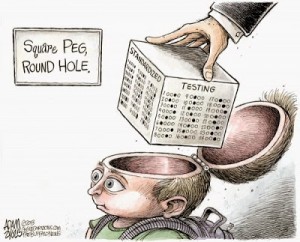National Common Core-aligned standardized tests for elementary and secondary schools are in the midst of a death spiral, despite the $360 million the Obama administration spent on the creation of the two consortia, the Partnership for Assessment of Readiness for College and Careers (PARCC) and Smarter Balanced, five years ago.
Only six states report they will administer PARCC testing in 2016; five years ago, PARCC proudly counted 23 states in its fold. Smarter Balanced also has been losing members — most recently Delaware and Montana — while receiving reviews similar to the following one made by a tech expert who was quoted in a Feb. 8 article in EdSurge, an online education-technology journal: “(Smarter Balanced is) a quagmire of poor technological design, poor interaction design, and poor mathematics that hopelessly clouds the insights the tests might give us into students’ thinking.”
Despite these significant setbacks, Common Core collaborationists in big government, business and foundations shouldn’t fret, because the College Board is now riding to the rescue.
College Board, with assistance from the Republican-led U.S. Congress, is seeing to it that its radically revised college-entrance exam, the SAT, can step right in as a replacement to the unpopular PARCC and Smarter Balanced tests to measure high school students’ Common Core-defined “college and career readiness.”
The Every Student Succeeds Act (ESSA), enacted in December 2015 as No Child Left Behind’s successor, lets states seek U.S. Department of Education permission to use the new SAT to evaluate all high school students’ Common Core competence, thereby also measuring the level of compliance schools have with the nationalized standards.
To understand how a test originally designed to help selective universities gauge applicants’ aptitude for intellectually challenging study can now be a yardstick of generic readiness, it is important to know the role former testing consultant David Coleman has in shaping the nation’s educational standards.
In 2008, Coleman and Gene Wilhoit, director of the Council of Chief State School Officers (CCSSO), visited philanthropist and Microsoft founder Bill Gates at his Seattle office to persuade him to bankroll the development of national education standards. The visit paid off; the Bill and Melinda Gates Foundation spent more than $200 million on the standards. The money was not used merely to develop Common Core under the aegis of the National Governors Association and CCSSO; it also was spent to increase public acceptance of the standards after their hasty, stealthy adoption by state boards of education, many of which were too busy lusting after federal Race to the Top grants tied to the standards to evaluate quality.
After their rollout in 2010 and the gradual rise in parents’ discontent over the standards, which occurred as parents began to discover drastic changes to their kids’ math and English classes, Coleman magically became president and CEO of the College Board.
From the get-go, Coleman said he intended to align the SAT fully with Common Core. When SAT testing begins in March, we’ll know for sure if Coleman is a man of his word, but SAT previews suggest the new SAT is likely to be another Common Core-aligned failure.
If the SAT becomes established as a graduation requirement under ESSA-mandated federal accountability, the standardization and centralized decision-making sought by Common Core’s elitist architects will become easier to achieve than it was under consortia testing.
States not fully on board with Common Core could find that their college-going students would be at a competitive disadvantage with students from states that strictly follow the Common Core curricular standards, and there’s no doubt that is the quandary the keepers of the Core want to present to dissenters in the hopes they too will fall into the common mold.
Robert Holland ([email protected]) is a senior fellow for education policy with The Heartland Institute.


